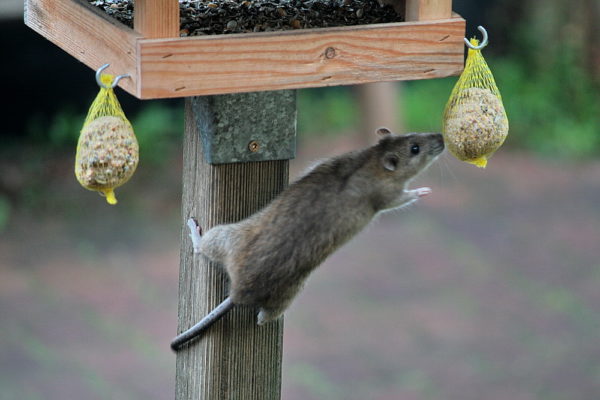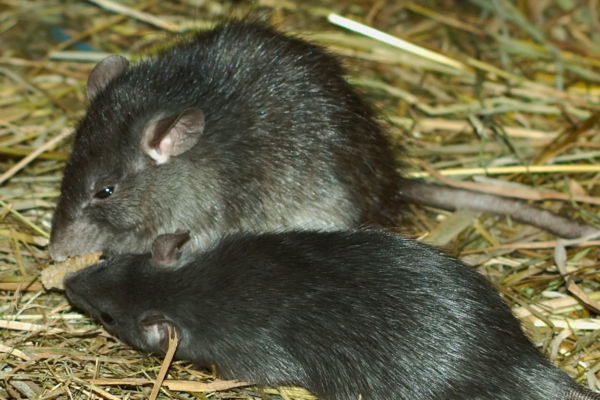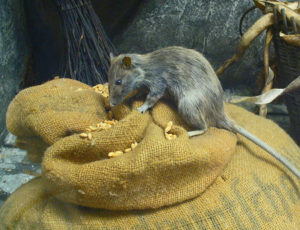Norway rats (Rattus norvegicus) and black rats (also known as ship rats), (Rattus rattus), are among the most prolific and widespread urban pest species in the world. But what do we know about their secret city lives? After all – the more we know, the better we can understand what we’re up against.

Just because you haven’t seen a rat doesn’t mean they’re not there… very near… cautious, watchful, eating, breeding…
Alice Feng and Chelsea Himsworth – researchers from British Columbia, Canada – carried out a review of current research knowledge in an article published in Urban Ecosystems. It offers some fascinating insights into urban rat lives. Here are some findings to ponder from the extensive article…
‘Norway’ rats come from China
Norway rats originated in northern China (not Norway) and black rats in India and Southern Asia. Both species spread around the world by hitching a lift with humans.
“Norway and black rats have caused chronic losses in traditional rice production systems in the order of 5–10 % of the total crop annually – a volume that could feed more than 180 million people for a year. In the United States, rats cause an estimated $19 billion dollars in economic damages annually through consumption and contamination of stored grains.”
Plagues and pathogens
“Rats are most famously associated with the Black Death (bubonic plague), which killed 40 % of the European population in the 14th century. However, Norway and black rats continue to be the source of a number of different pathogens responsible for significant human morbidity and mortality in cities around the world, including Leptospira spp., Seoul hantavirus, murine typhus, and even Yersina pestis (the causative agent of the plague).”
City life suits them
Urban rats tend to grow faster and become sexually mature more quickly than their country cousins.
“The rat gestation period is approximately 3 weeks. In urban environments where conditions are favorable, rats may reproduce year round and have as many as 5 litters per year with 4–8 young per litter. Additionally, number of young per litter will increase with the size and maturity of the female.
Why populations can ‘explode’
“Female rats living in groups have been observed to establish oestrus synchrony. This synchrony is significant because it can result in coordinated population booms as large numbers of young are weaned and enter the population almost simultaneously. Interestingly, among females that reproduce synchronously, approximately 80 % of pups will survive till weaning compared to 28 % pup survival in females that reproduce asynchronously. When pups are born synchronously, there are more lactating females that are able to nurse young and less competition among pups. It is thought that litters born asynchronously have higher mortality rates due to competition from older pups.”
Live hard, die young

“Wild rats have very short life spans. The probability of dying is 90–95 % per year, meaning that most rats do not survive beyond 1 year of age. Males tend to die at a younger age than females. Although there is little information on the causes of rat mortality, it has been suggested that mortality is primarily a function of resource limitations combined with interspecific competition. The effect of predation is thought to be negligible in a well established population. Predators such as cats tend to kill smaller rats, resulting in the selective removal of juveniles.”
Eat fast, live longer
“Black (ship) rats preferentially consume fruits, nuts, and seeds, while Norway rats, being more omnivorous by nature, will eat a wide array of feedstuffs. Food preference in rats is influenced by previous experience and nutritional value of food. However, rats are incredibly opportunistic and will adapt to a variety of foods, therefore food selection is largely determined by availability.”

“Feeding behaviour in rats is best predicted by time taken to consume food, which is, in turn, determined by the size of the food stuff. Small pieces of food (crumbs, flour, wheat, etc.) are eaten directly where they are found, while larger morsels tend to be carried to a secluded area for undisturbed consumption. Rats generally avoid open areas and tend to feed close to cover with the exception of dominant rats, who are more likely to consume food directly at the food source. Large food items are often selected preferentially when both small and large items are available, and rats may attempt to gather and carry multiple food items during a single outing.”
In bed by midnight
“Rats are generally nocturnal and most often forage shortly before or at sunset. The majority of rat activity tends to occur before 12 a.m., after which very few rats are sighted. Younger rats, however, may forage earlier in the day to avoid competition from older, larger rats. Rain and inclement weather have been reported to discourage outdoor rat activity, while presence of humans does not appear to disturb rats or alter their feeding patterns.”
Rats have phobias too
“Neophobia is a strong and consistent behavioral characteristic among rats and one that presents a major obstacle for rodent control and management. Neophobia is the fear of novel stimuli, and manifests as avoidance of new food or situations. It is an adaptive behavioural response that encourages survival of cautious creatures. Degree of neophobia will vary between species, among populations of the same species, and among individuals.”
It’s our fault
“It has been suggested that the highly developed neophobia observed in both Norway and black rats have evolved as a response to intense human control. For example, as the amount of poisoned food in the environment increases, rats become less likely to sample novel food and more likely to pay attention to the eating habitats of others.”
Urban barriers ‘fence them in’
“The distribution of rats in an urban environment depends on environment suitability, as well as the presence of barriers to rat movement. City streets are among the most significant barriers and tend to separate rats into isolated populations with a population’s home range being limited to a city block.”
Like human city-dwellers, urban rats have smaller territories than their country counterparts.
“Barriers to rat movement cause the home ranges of urban rats to be very small when compared to rats living in rural areas. Although often confined to a city block, a rat’s home range often encompasses more than one dwelling or property at any given time. Despite their small home range, dispersal of rats over short distances is not uncommon and is often successful in urban settings.”
Finding the perfect rat-pad
“In urban environment, food and organic waste that are improperly stored or disposed of constitutes the most significant food source for rats. Interestingly, presence of domestic animals at a residence may also attract rats due to the fact that pet food is often left out for long periods of time and may be easily accessible. Although access to water has received less attention in studies of rat ecology, it is no doubt an important factor, as rats require daily access to fresh water for survival.”
Don’t make it easy for them
“While food may determine the size of a rat population, the availability of harborage will determine whether a population is able to become established in the first place. A premise is 24.2 times more likely to become infested when that structure is easily accessible to rats. While black rats tend to enter these structures through holes in the roof, cracks in walls or ceilings, or access points near utility lines, Norway rats tend to enter structures through sewage systems, as well as cracks or holes in a building’s foundations. Although rats will cohabit with people, abandoned structures are preferred, and may serve as a source of infestation within a block.”
Different preferences
“Norway rats may also create their own harborage by burrowing. The presence of natural soil is a strong predictor of Norway rat populations and that Norway rats are uncommon in heavily built up areas of a city where there is little natural soil available for burrowing. Black rats, on the other hand, are more adept at scaling vertical structures and creating nests out of artificial materials, and are therefore common in areas with high building density.”
This article is published in Urban Ecosystems where the abstract is freely available online.
The full article is freely available online through Researchgate:

